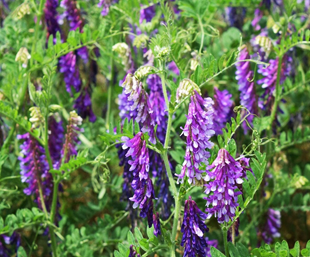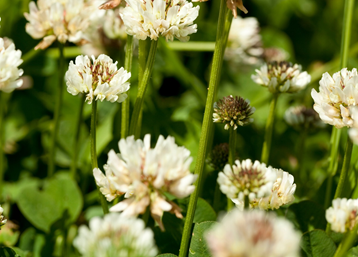-A Practical Guide To Farming Quality Cannabis 6 Hemp
Written by:
Bryan Wachsman
Daniel Enking, Everflux Technologies Founder & CEO
The Best Methods to Improve Your Grow
I still can visualize the first time I watched the Mendo Boys cannabis street team interview a cannabis underground LEGEND, known simply as "Minnesota Nice." The video was about as basic as it gets and filmed with an older iPhone in a humble basement in Minnesota. This original video was another "ah-ha" moment for me as Minnesota Nice pulled out a red solo cup with a small cannabis clone, and I saw that there was some other kind of plant growing at the base of the clone. Mr. Nice began explaining how certain cover crops can pull nitrogen from the air and bring it down directly into the soil. I was confused as well as intrigued about what they were explaining. I watched that video maybe 5-6 times that night. Pretty soon, learning how to incorporate specific companion plants when growing cannabis became my new pet project.
What Companion Planting is All About?
Companion planting is about which specific beneficial plants improve the conditions and overall health of the plant you are trying to grow. Certain beneficial plants protect your plants against common pests by emitting a robust smell. Some other plants will actually improve soil conditions through aeration and nutrient promotion. At the same time, a select few will provide structural support and reduce the need for additional cultivation space.
Companion planting is an inexpensive, planet-friendly, long-term organic solution that provides natural insecticides and fungicides for your garden, grow or farm. Living soil, organic mulch, green and brown manure, and added boosts of nutrients, vitamins, and minerals can all be achieved by planting living things that work together in a symbiotic relationship with your plants. Your plants will respond to this symbiotic approach with greater resistance to disease and pests, noticeably more vigorous growth, and more substantial yields with more essential oil production.
Companion planting causes soil to come alive as bio-diverse micro-ecosystems improve the overall quality of the living soil, water penetration, retention, and bio-availability of nutrients. Healthy living soil companion gardens attract beneficial insects and small creatures that prey on pests that are known to damage cannabis and hemp. Companion plants often help disguise the unique cannabis or hemp silhouette, and the unique aromas from several flowering species help obscure where the pungent aromas originated from.
Cannabinoid producing plants have also found a way to make their own defenses. The cannabis plant creates THC as a natural repellent that deters hundreds of pests from attacking her. However, most common cannabis and hemp pests are not deterred by the psychotropic qualities of this cannabinoid.
Companion Crops
COMPANION CROPS
These plants have the strongest anti- pest effects when planted with cannabis or hemp plants.For indoor grows, they are best grown in separate pots right next to your cannabis or hemp plants.
Mint: Mint is a strategic plant with an appealing smell to humans but is less-than-appealing to most cannabis pest infestations. Mint is also known to help cover-up the scent of freshly blooming bud sites. Please be proactive and remember that mint tends to be very invasive, so plan mint into fabric air pots around your cannabis, rather than directly with them in your raised beds.
Basil: Basil has become a staple in my grows due to its pungent scent that is known to repel and disperse cannabis plant pests like flies, beetles, aphids, and thrips. Basil is also believed to help increase overall oil production and can improve the flavor of nearby plants.
Cover Crops
These crops are the best species to grow in the same bed as your main crop, and provide other benefits to the soil such as nitrogen fixation, improving soil health and structure, and in some cases deterring pests.
Flax - Carter: As a cover crop, flax helps to mobilize phosphorus in the soil and add organic matter. An excellent companion seeding crop for use with small-seeded grasses and legumes due to its early maturity, limited leaf area, and less extensive root system.
Millet - White Proso: Millet, White Proso is a warm season bunch grass. The plants grow quickly when it is warm and produce a lot of biomass to cover the soil or till in. It grows well without supplemental water or fertilizer once established.
Vetch - Hairy: Hairy vetch fixes large amounts of nitrogen, protects soil from erosion, helps improve soil tilth, and provides weed control during its vigorous growth. Research has shown that hairy vetch mulch can increase the primary crop disease resistance and prolong leaf photosynthesis of the following crop. In a no-till environment indoors, harry vetch is an excellent choice for nitrogen-fixing and companion planting as well as bringing the organic matter back to the soil when chopped down.
Vetch - Common: If you are looking for a workhorse cover crop, look no further than vetch. Few legumes contribute as much nitrogen or biomass to the garden. Vetch produces an abundance of vining stems and fine foliage that help protect soils from wind and rain, while improving structure and adding nutrients. Plant vetch as a cover crop or green manure and reap the rewards of healthy, thriving soil.
Cowpeas - Red Ripper: Adapted to a wide range of soil types, Red Ripper cowpeas can handle sandier soils much better than Iron & Clay cowpeas. They also flower and make seed earlier than Iron & Clay. Commonly used by farmers for silage and as a cover crop, but also widely planted as a high protein forage.
Buckwheat - Mancan: Buckwheat is a short-season cover crop. It establishes blooms and reaches maturity in just 70 to 90 days, and its residue breaks down quickly. Buckwheat suppresses weeds and attracts beneficial insects and pollinators with its abundant blossoms. It is easy to kill and extracts soil phosphorus from soil better than most grain-type cover crops. Buckwheat grows prolifically indoors in containers or soil beds. It makes an excellent choice as part of a cover crop blend for cannabis.
Pea - Forage: Rhizobium bacteria helps legume (eg. peas, beans) crops such as the winter field peas fix nitrogen in the soil. What this means is that nitrogen in the air is actually captured by the plants and then in turn released in the soil when the plants die or are cut down.
The above-mentioned companion plants also act as camouflage in several ways. The variety of texture, colors, and depths of perspective help disguise the growing cannabis plant. Smaller organic species like indicas and autoflowers will virtually disappear in a well-populated garden. The many fragrant choices of companion plants also help confuse the distinctive cannabis bouquet in a potpourri of exotic smells.
The Benefits to Gain from these Green Companions
As a diverse mini-jungle awash with color, aroma, and functionality or a select few multipurpose species, companion plants will benefit your marijuana in several ways.
Companion plants support growth and vigor, increase oil production, and resilience while repelling bad bugs and attracting the good. Cost-effective and pollution-free companion planting is a bonus to the wallet and the planet.
In recent years, more consumers are becoming informed and alarmed about the pesticides used in commercial cannabis.
This has caused many home growers to take action and opt for an at-home, organic approach to their cultivation of high cannabinoid medicine. These home farmers are learning that trying to avoid chemical, synthetic-based pesticides and fertilizers while still safeguarding cannabis rooms against threats of pest and disease can become extremely frustrating. Detrimental insects, small rodents, and other small animals are drawn to cannabis like we are, so it's essential to diligently monitor the condition of your cannabis grow throughout its entire life cycle. Companion and cover crops can help to significantly decrease these pest threats.
Another Easy Way to Defend Against Pests and Increase Nutrient Availability
Part of the effect of companion and cover crops is that different plants attract and promote different soil microbial life, increasing soil biodiversity. In fact, maximizing biodiversity is ultimately the key to both ensuring proper nutrient uptake by plants and defending against all sorts of pests and disease. Microbes evolved to work in symbiosis with plant’s roots, and so the more species present, the more chances that the right microbe will be there to give the plant the food it needs or defend it from a specific pest or disease.
Bioflux fermented plant boost contains 11 billion microbes per gram and hundreds of different species.
It’s extremely easy to add a little Bioflux to your regular watering once a week, and see the difference it makes for the overall health of your plants. If you don’t want the time-consuming hassle of making your own compost tea or KNF style fermented plant juice, Bioflux is an easy and affordable substitute.
We would like to thank Everflux for sharing this invaluable insights and information to us.
To know more about this technology:
Growing Trial with Bioflux
To learn more about living soil cultivation:








